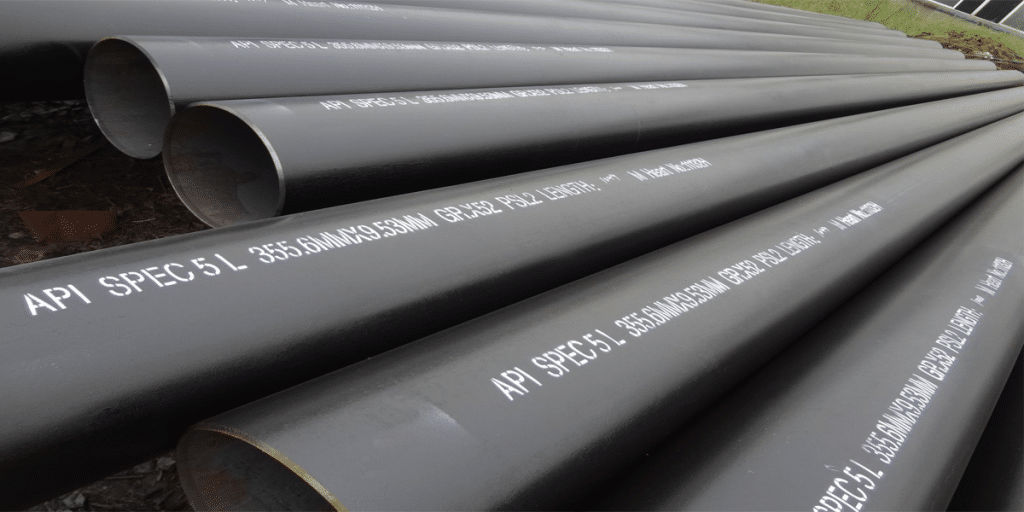In the global alloy steel pipe market, ASTM A691 and ASTM A335 are two of the most widely used standards for high-temperature and high-pressure service. Both are essential in industries such as power generation, petrochemicals, refineries, and energy transportation.
While they share similarities in alloy composition and mechanical properties, their manufacturing process, application fields, and performance standards differ significantly. This article provides an in-depth comparison between ASTM A691 and ASTM A335 to help buyers make an informed choice—while showcasing the quality and expertise of LONGMA Steel Pipe, a trusted manufacturer with over 20 years of experience in producing high-performance alloy steel pipes.
Understanding ASTM A691 and ASTM A335
| Standard | Full Name | Production Method | Application | Typical Grades |
| ASTM A691 | Electric Fusion Welded (EFW) Alloy Steel Pipe | Welded | High-pressure service at elevated temperature | astm a691 grade 2.1 4cr, astm a691 cl32 |
| ASTM A335 | Seamless Ferritic Alloy Steel Pipe | Seamless | Boiler, heat exchanger, and superheater systems | P1, P5, P9, P11, P22, P91 |
ASTM A691 pipes are made by welding steel plates using the Electric Fusion Welding (EFW) process, followed by heat treatment to achieve mechanical uniformity. In contrast, ASTM A335 pipes are seamless, offering superior pressure resistance and reliability in extremely high-temperature environments.
Main Technical Differences
Manufacturing Process
- ASTM A691uses EFW welding, which allows for thicker walls and larger diameters. It is ideal for high-capacity pipelines and power plant pressure systems.
- ASTM A335, being seamless, eliminates weld seams and is preferred for high-pressure, small-diameter pipelinesin boilers and superheaters.
| Parameter | ASTM A691 | ASTM A335 |
| Manufacturing Method | Electric Fusion Welded | Seamless |
| Pipe Diameter Range | Up to 1200 mm | Up to 660 mm |
| Wall Thickness | 6–50 mm | 3–25 mm |
| Pressure Resistance | High | Very High |
| Common Grades | astm a691 grade 2.1 4cr gr 32 | P5, P9, P22 |
| Heat Treatment | Normalized, Tempered | Normalized, Tempered |
Mechanical Properties
Both standards require strict mechanical testing. However, ASTM A335 generally offers higher tensile and yield strength due to its seamless nature.
| Property | ASTM A691 Grade 2.1 4Cr CL32 | ASTM A335 P9 |
| Tensile Strength (MPa) | 485 – 620 | 585 – 760 |
| Yield Strength (MPa) | ≥275 | ≥325 |
| Elongation (%) | ≥20 | ≥30 |
| Hardness (HBW) | ≤200 | ≤225 |
ASTM A691 CL32 indicates a Class 32 level of testing, meaning that both the weld joint and base metal are subjected to non-destructive testing (NDT), such as radiographic or ultrasonic inspection, ensuring weld quality and durability.
Chemical Composition Comparison
The chemical composition defines each pipe’s ability to withstand heat, corrosion, and pressure. Both A691 and A335 contain chromium and molybdenum, but A691 grades allow for broader flexibility due to welded fabrication.
| Element | ASTM A691 Grade 2.1 4Cr | ASTM A335 P9 |
| Carbon (C) | 0.15 max | 0.12 max |
| Manganese (Mn) | 0.30–0.60 | 0.30–0.60 |
| Chromium (Cr) | 3.00–5.00 | 8.00–10.00 |
| Molybdenum (Mo) | 0.40–0.65 | 0.90–1.10 |
| Silicon (Si) | 0.50 max | 0.50 max |
While ASTM A335 P9 has higher chromium content for enhanced oxidation resistance, ASTM A691 Grade 2.1 4Cr provides an excellent balance of strength, weldability, and cost-effectiveness—making it ideal for high-pressure water lines and refinery piping.
Testing and Quality Control
LONGMA strictly follows ASTM testing protocols to ensure reliability in every pipe produced.
| Test Type | Standard Reference | Purpose |
| Hydrostatic Test | ASTM A999 | Verifies pressure integrity |
| Ultrasonic Test (UT) | ASTM E213 | Detects internal weld flaws |
| Radiographic Test (RT) | ASTM E94 | Ensures weld fusion quality |
| Chemical Analysis | ASTM E415 | Confirms material composition |
| Mechanical Testing | ASTM A370 | Measures tensile and yield strength |
LONGMA’s in-house laboratory performs each of these tests with advanced equipment, ensuring the highest compliance with ASTM standards. These rigorous checks enhance customer confidence and reduce procurement risks.
Application Scenarios
- ASTM A691 Pipe
Widely used in power generation units, refineries, and petrochemical plants, especially where large-diameter, high-pressure pipingis required. LONGMA’s astm a691 cl32 and astm a691 grade 2.1 4cr gr 32 pipes are among the most sought-after by clients in Spain, the Middle East, and Southeast Asia. - ASTM A335 Pipe
Preferred in boiler tubes, heat exchangers, and superheatersdue to its seamless structure and exceptional heat resistance.
Export Market and LONGMA Brand Advantage
As one of the leading China alloy steel pipe manufacturers, LONGMA exports ASTM A691 pipes & tubes in Spain, South America, and Europe, providing full project documentation, third-party inspection (TPI), and customized specifications.
LONGMA Advantages:
- Over 20 yearsof experience in EFW alloy pipe production.
- ISO 9001 and PED-certified manufacturing facilities.
- Advanced heat treatment and NDT systemsfor stable quality.
- Capability to produce both astm a691 pipeand astm a335 seamless tubes according to customer design.
Conclusion
Both ASTM A691 and ASTM A335 alloy steel pipes serve crucial roles in high-pressure, high-temperature environments.
- Choose ASTM A691for large-diameter welded applications requiring flexibility and cost-efficiency.
- Choose ASTM A335for seamless systems needing maximum strength and integrity under extreme conditions.
As a professional manufacturer and exporter, LONGMA Steel Pipe continues to deliver superior astm a691 pipe products, earning trust through quality, precision, and professional service in the global market.



